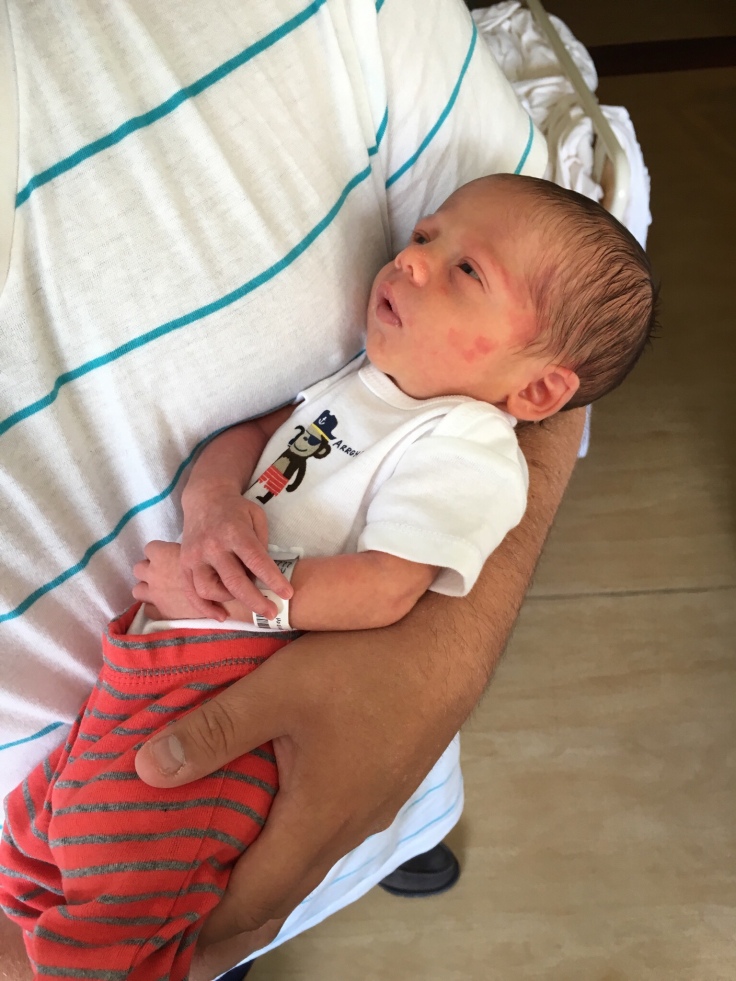
 The next morning, visitors began proceeding in to meet Greyson, or “baby G” as we all called him. My parents, sisters and Derek’s family all came to meet the newest Martin. I don’t quite remember who pointed it out, but someone had asked about the pink splotches on G’s face. We had noticed a small spot shortly after he came out, but didn’t notice the extent of that spot since majority of it was hidden under his newborn cap.
The next morning, visitors began proceeding in to meet Greyson, or “baby G” as we all called him. My parents, sisters and Derek’s family all came to meet the newest Martin. I don’t quite remember who pointed it out, but someone had asked about the pink splotches on G’s face. We had noticed a small spot shortly after he came out, but didn’t notice the extent of that spot since majority of it was hidden under his newborn cap.
When you see his birthmark, it begins on his left cheek, wrapping up along his temple, eyebrow, scalp, ear and down the back of his neck. We were told that sometimes newborns have “storkbites” and it should disappear by 6-12 months of age. But as G began to grow, so did this birthmark.
Greyson was developing as a typical child would. Derek and I marked each month of his birth by dragging the kids outside with a camera and taking photos with the ever-so popular belly stickers, which showed how many months old he was. This actually helped us more than for just sentimental keeping. It allowed us to keep tabs on when we eventually began noticing something was off with G, and when he began his regressed eye contact and facial expressions.
G was a much more serious baby than Roslynn was. He cried more often and at a much higher pitch than she did. Now I know what you’re thinking….”all children are different, you can’t compare them.” I get that, but when we began noticing more and more differences between the kids, we began to really note them. Every time we had a well-child check, we were reassured that G was fine and that he was developing appropriately. At Greyson’s 12-month followup, our amazing pediatrician, Dr. Miller noticed that G was flopping around and had poor muscle tone. Red flag.
Upon Dr.Miller’s recommendation, we had Early Intervention (EI) come out to evaluate Greyson. We had noticed that he was still not making any attempts at communicating, had diminished eye contact and didn’t make faces that matched his emotions. When EI came to the house in October 2016, I was still not convinced that there was a big problem with G’s development and did not want to seem hyper-aware of the smallest things. I’ve noticed that in my line of work at The Center for Autism and Developmental Disabilities (CADD), I was always thinking of the “what ifs” and I didn’t want to be that parent who always worried. EI was also immediately concerned with Greyson. The evaluator determined that G met the criteria for services in the following categories- emotional, communication, cognitive and adaptive functioning. They also noticed that he was having staring spells and zoned out often, which is one symptom of absent seizures. They referred us to a neurologist and to receive an evaluation at CADD for anything else that could be going on with Greyson.
I currently work at CADD as a Behavioral Health Office Assistant (a long fancy title for a secretary). I have amazing coworkers that are compassionate and true experts in Autism Spectrum Disorders. I knew that I was going to have the best team to evaluate Greyson. We also set up an intake appointment with Dr. Gottlieb, a pediatric neurologist at Nemours in Lancaster. I knew of Dr. Gottlieb through work, as many of our clients have been to see him for their neurological concerns. At the intake with Dr. Gottlieb, he confirmed that he believed G could possibly have absent seizures and he thought it was a good idea that the MDE (multidisciplinary evaluation) team at CADD was going to do an evaluation. He referred us for an EEG and MRI to confirm or rule-out any seizure activity. At the end of the intake appointment, Dr. Gottlieb looks at Greyson’s birthmark and asked, “how long has he had this port-wine stain?”. To which I reply, “oh, the birthmark?Since birth, but we are waiting for it to fade like the doctors have said will happen.” He asked if we had any vision concerns with G, which reminded me of how often he walked into things and held things extremely close to his face to see them. This prompted us to receive a referral to a pediatric ophthalmologist to also check his vision. I distinctly remember the last thing Dr. Gottlieb said to me at that applintment: “It could be something related to autism or developmental delay, but Greyson’s symptoms are also noted in patients with Sturge-weber Syndrome.”
I get Greyson in his car seat and get in the drivers seat of my SUV. Sturge-weber Syndrome? What in the hell is that?
Little did I know, this was opening up an entirely new can of worms.
Thanks so much for sharing your story!!
LikeLike